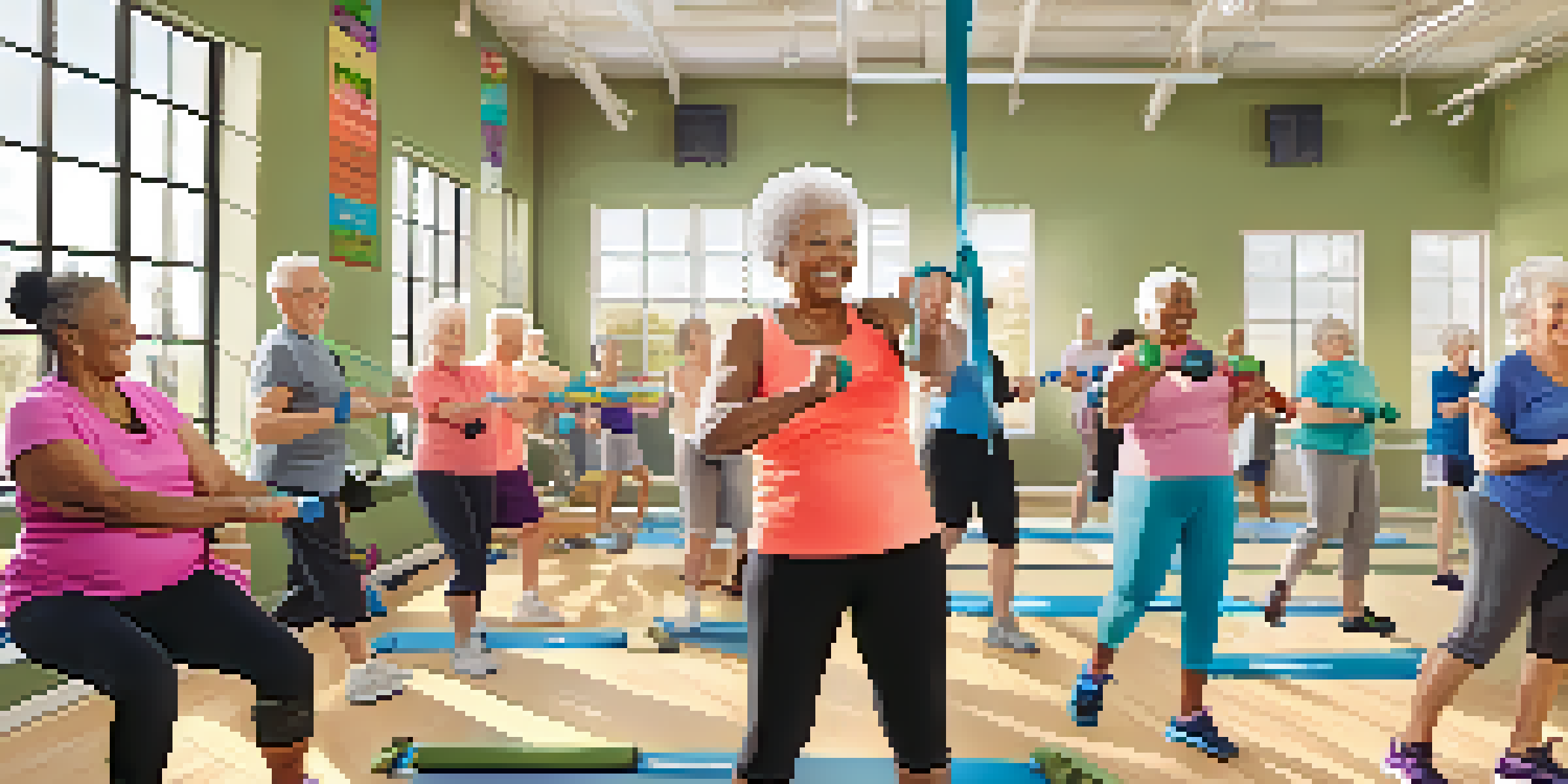Bodybuilding Techniques for Enhancing Mobility in Seniors

Understanding the Importance of Mobility for Seniors
Mobility is crucial for seniors as it directly impacts their independence and quality of life. It allows them to perform daily activities, engage in social interactions, and maintain overall health. By enhancing mobility, seniors can also decrease the risk of falls, which are a common concern as we age.
The greatest wealth is health.
Incorporating mobility-focused exercises into a senior's routine can lead to improved balance and flexibility. This not only helps in reducing stiffness but also strengthens muscles that support joints. Think of mobility as the key to keeping the body functioning smoothly, much like oil in a car engine.
Moreover, better mobility contributes to mental well-being, allowing seniors to feel more confident and active. When they can move freely, they are more likely to participate in community activities. Thus, enhancing mobility is not just about physical fitness; it’s about fostering a vibrant lifestyle.
Gentle Strength Training: A Foundation for Mobility
Strength training is often misunderstood as being only for bodybuilders, but it plays a vital role in enhancing mobility for seniors. Engaging in gentle strength exercises helps build muscle mass, which naturally declines with age. This increase in muscle strength translates to better support for joints and improved balance.

Resistance bands and light weights are fantastic tools for seniors to start strength training. These tools provide an effective way to strengthen muscles without the strain of heavy lifting. For example, using a resistance band for bicep curls can help improve upper body strength while also being easy on the joints.
Mobility Enhances Quality of Life
Improving mobility helps seniors maintain independence, engage socially, and decrease the risk of falls.
Incorporating strength training into a regular routine can lead to significant improvements in daily activities. Seniors may find tasks like lifting groceries or standing up from a chair easier. Strengthening the body is like building a solid foundation for a house; it supports everything else.
Incorporating Flexibility Exercises into Daily Routines
Flexibility exercises are essential for maintaining a wide range of motion in joints. As we age, our muscles and connective tissues can become tighter, leading to discomfort and reduced mobility. Incorporating simple stretches into a daily routine can help counteract this tightness and promote better movement.
It is health that is real wealth and not pieces of gold and silver.
Activities like yoga and tai chi are excellent for improving flexibility and balance. These practices not only stretch the body but also encourage mindfulness, creating a holistic approach to fitness. Imagine your muscles loosening up, like a rubber band that has been stretched and can now move freely.
Regular flexibility exercises can also enhance circulation and reduce the risk of injuries. Even just dedicating 10-15 minutes a day to stretching can yield noticeable benefits over time. It's like giving your body a gentle tune-up, allowing it to perform at its best.
Balance Training: Preventing Falls and Enhancing Mobility
Balance training is a crucial aspect of any fitness regimen for seniors. It focuses on improving stability, coordination, and the ability to recover from potential falls. Simple exercises like standing on one leg or walking heel-to-toe can significantly improve balance over time.
Incorporating balance training into a routine can help seniors feel more secure in their movements. For instance, practicing balance on a stable surface can build confidence before attempting it on more challenging terrain. Think of it like practicing for a dance; the more familiar you are with the steps, the more graceful you become.
Strength Training Supports Mobility
Gentle strength training builds muscle mass, which is essential for better joint support and balance.
Furthermore, enhancing balance not only prevents falls but also encourages seniors to engage more freely in activities they enjoy. Whether it’s gardening or taking a walk in the park, improved balance opens up new possibilities. Every step taken with confidence is a step towards a healthier, happier life.
Embracing Low-Impact Cardio for Overall Health
Low-impact cardiovascular exercises are perfect for seniors looking to enhance their mobility. Activities like walking, swimming, or cycling provide essential heart health benefits without putting undue stress on the joints. These exercises also improve endurance, making daily activities feel less tiring.
Engaging in low-impact cardio can boost energy levels and mood, which is vital for overall well-being. For example, a brisk walk around the neighborhood not only gets the heart pumping but also offers an opportunity to enjoy nature and socialize with neighbors. It’s like a breath of fresh air for both the body and mind.
Incorporating just 20-30 minutes of low-impact cardio several times a week can lead to significant improvements. Seniors may find they have more stamina for activities they love, from playing with grandchildren to participating in community events. It’s about finding joy in movement, one step at a time.
The Role of Nutrition in Supporting Mobility
Nutrition plays an often-overlooked role in enhancing mobility for seniors. A balanced diet rich in vitamins and minerals supports muscle and bone health, which is crucial for maintaining physical activity. Foods high in calcium and vitamin D, such as dairy products and leafy greens, help strengthen bones.
Additionally, protein is essential for muscle repair and growth. Seniors should consider incorporating lean meats, beans, and legumes into their meals to ensure they are getting enough protein. Imagine your body as a car; the right fuel keeps it running smoothly, allowing you to go the distance.
Nutrition Fuels Physical Activity
A balanced diet rich in essential nutrients supports muscle and bone health, crucial for maintaining mobility.
Hydration is also key, as it helps maintain joint lubrication and overall bodily functions. Seniors should aim to drink plenty of water throughout the day, especially during physical activities. Remember, good nutrition is like the foundation of a house; without it, everything else can crumble.
Creating a Consistent Routine for Lasting Results
Establishing a consistent exercise routine is essential for seniors to reap the benefits of mobility-enhancing techniques. Setting aside specific days and times for workouts can help in forming a habit. Like watering a plant regularly, consistency nurtures growth and improvement.
Finding activities that are enjoyable makes it easier to stick to a routine. Whether it’s joining a local exercise class or walking with a friend, engaging in social aspects of fitness can make it more fun. It’s much like having a workout buddy; the shared experience keeps motivation high.

Lastly, tracking progress can be incredibly motivating. Seniors can keep a journal of their activities or use fitness apps to monitor improvements. Each small step forward is a victory worth celebrating, reinforcing the journey towards better mobility and overall health.